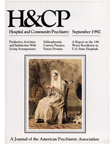Length of Time Spent in Seclusion and Restraint by Patients at 82 VA Medical Centers
Abstract
Analysis of data from 82 Veterans Affairs medical centers showed that during a one-year period in 1987-88, VA psychiatric inpatients spent about 240,000 hours in seclusion or restraint, with about half of that time in mechanical restraints. The median length of time patients in each medical center spent in seclusion and restraint was used to classify centers as having "higher" or "usual" rates of use of those techniques. In the 20 centers classified as higher users, patients spent two to three times longer in seclusion and restraint per incident than patients in the 62 centers classified as usual users. Time spent by patients in seclusion and restraint in centers with usual rates of use was consistent with reports from other U.S. studies. The longer time in seclusion and restraint per incident in higher-user centers may be due to characteristics of the medical center or of the patient population.
Access content
To read the fulltext, please use one of the options below to sign in or purchase access.- Personal login
- Institutional Login
- Sign in via OpenAthens
- Register for access
-
Please login/register if you wish to pair your device and check access availability.
Not a subscriber?
PsychiatryOnline subscription options offer access to the DSM-5 library, books, journals, CME, and patient resources. This all-in-one virtual library provides psychiatrists and mental health professionals with key resources for diagnosis, treatment, research, and professional development.
Need more help? PsychiatryOnline Customer Service may be reached by emailing [email protected] or by calling 800-368-5777 (in the U.S.) or 703-907-7322 (outside the U.S.).



